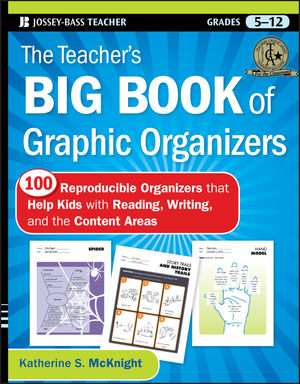The Teacher's Big Book of Graphic Organizers: 100 Reproducible Organizers that Help Kids with Reading, Writing, and the Content AreasISBN: 978-0-470-50242-6
Paperback
224 pages
June 2010, Jossey-Bass
 |
||||||
Acknowledgments viii
About the Author ix
Chapter One Why Are Graphic Organizers Such Important Tools for Teaching and Learning? 1
Chapter Two Graphic Organizers for Brainstorming and Idea Generation 5
1: Power Thinking (Levels of Brainstorming) 6
2: ABC Brainstorm 8
3: Carousel Brainstorm 10
4: Venn Diagram 12
5: Compare and Contrast 14
6: KWL 16
7: KWS 18
8: KWHL 20
9: KWLT 22
10–17: Topic Generation Graphic Organizers
10: Topic Generation with 3 Ideas–Linear Model 24
11: Topic Generation with 4 Ideas–Linear Model 26
12: Topic Generation with 6 Ideas–Linear Model 28
13: Topic Generation with 3 Ideas–Circle Model 30
14: Topic Generation with 4 Ideas–Circle Model 32
15: Topic Generation with 6 Ideas–Circle Model 34
16: Character Traits Web 36
17: Topic Generation: Hand Model 38
18: Anticipation Guide 40
19: Hypothesis Guide 42
20: Idea Web 44
21: Fishbone 46
22: Spider 48
23: Herringbone 50
24: Y Diagram 52
Chapter Three Graphic Organizers for Vocabulary Development 55
25: Vocabulary Slide 56
26: Concept or Vocabulary Map I 58
27: Concept or Vocabulary Map II 60
28: Concept or Vocabulary Map III 62
29: Concept or Vocabulary Map IV 64
30: Word Detective 66
31: Six-Column Vocabulary Organizer 68
32: Vocabulary Tree 70
33: Cyber Vocabulary Detective 72
Chapter Four Graphic Organizers for Note Taking and Study Skills 75
34: Cornell Notes 76
35: Three-Column Notes 78
36: T Notes 80
37: Analysis Notes 82
38: Summary Organizer 84
39: Journalist Graphic Organizer 86
40: Story Board Notes: Three Frame 88
41: Story Board Notes: Six Frame 90
42: Outline Notes 92
43: The Five Senses 94
44: Cycle or Food Chain 96
45–48: Graphic Organizer Bookmarks 98
45: Bookmark for Reading Fiction 99
46: Reading Reminders Bookmark 100
47: Bookmark for Questions During Reading 101
48: Textbook Reminders Bookmark 102
49: Individual Performance in a Cooperative Group 104
50: Cooperative Group Planner 106
51: Portfolio Tracker 108
52: Independent Reading Log 110
53: Assignment Tracker 112
Chapter Five Graphic Organizers for Supporting Reading Comprehension 115
54: Questioning the Author 116
55: Question-Answer-Relationship (QAR) 118
56: Gist 120
57: Survey, Question, Read, Recite, Review (SQ3R) 122
58: Survey, Question, Read, Recite, Review, Reflect (SQ4R) 126
59: Fix-Up Strategies 130
60: Reading Connections 132
61: ReQuest 134
62: Story Trails and History Trails 136
63: Text-Think-Connect (TTC) 138
64: REAP 140
65: PLAN 142
66: PACA 144
67: DRTA 146
68: Text Structures 148
69: Reference Frames 150
70: Prior Knowledge 152
71: Inference Prompter 154
72: List-Group-Label 156
73: Think-Pair-Share 158
74: The Five Ws 160
Chapter Six Graphic Organizers for Writing 163
75: Autobiographical Poem 164
76: Historical Bio Poem 166
77: Inquiry Chart 168
78: Peer Review 170
79: Entrance Slip 172
80: Exit Slip 174
81: Writer Checklist 176
82: Sensory Starter 178
83: Story Map I 180
84: Story Map II 182
85: Chain of Events 184
86: Beginning-Middle-End 186
87: Climax Ladder 188
88–91: Persuasive Writing Organizers 190
88: Persuasive Writing I 191
89: Persuasive Writing II 192
90: Persuasive Writing III 193
91: Persuasive Writing IV 194
92: Writing Revision Organizer 196
93: Prewriting Organizer 198
94: What Happens? 200
95: Character Creator 202
96: Conflict and Solution Organizer 204
97: Getting Ready to Write 206
98: Writing Process 208
99: Story Pyramid 210
100: RAFT 212
References 214



